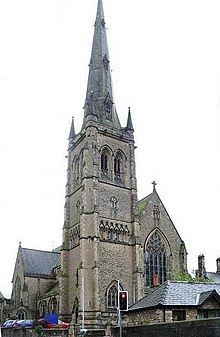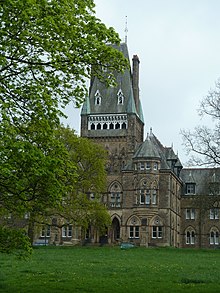Edward Graham Paley
Edward Graham Paley | |
|---|---|
 E. G. Paley in 1868 | |
| Born | 3 September 1823 Easingwold, North Yorkshire, England |
| Died | 23 January 1895 (aged 71) Lancaster, Lancashire, England |
| Occupation | Architect |
Edward Graham Paley, usually known as E. G. Paley (3 September 1823 – 23 January 1895), was an English architect who practised in Lancaster, Lancashire, in the second half of the 19th century. After leaving school in 1838, he went to Lancaster to become a pupil of Edmund Sharpe, and in 1845 he joined Sharpe as a partner. Sharpe retired from the practice in 1851, leaving Paley as the sole principal. In 1868, Hubert Austin joined him as a partner, and in 1886, Paley's son, Henry, also became a partner. This partnership continued until Paley's death in 1895.
Paley's major work was the design of new churches, but he also rebuilt,
Paley played little part in the political life of Lancaster, but he was involved with cultural events and sports in the town. His interests included music and archaeology, and he was involved in archery and rowing. In addition to designing the Royal Albert Asylum, he served on its committee, as well as being on the committees of local schools and the Mechanics' Institute. His work tended to be eclipsed in the later part of his career by Austin, and Paley is regarded as having been a competent architect, rather than a great one.
Early life
Edward Paley was born in Easingwold, North Yorkshire, the seventh child and the fourth son of Revd Edmund Paley and Sarah née Apthorp. His older brother, Frederick Apthorp Paley, was a classical scholar. His father was the local vicar, who in turn was second son of William Paley, the Christian apologist. Edward was initially educated at home, and later at Christ's Hospital when it was situated in London. From school he went directly to Lancaster in 1838 to become a pupil of the architect Edmund Sharpe at the age of 15.[1][2]
Career and works

1845–68
In 1845, after Paley had completed his articles, Sharpe appointed him as a partner in the practice,[3] which was known as Sharpe and Paley, Architects,[4] (or more usually as Sharpe & Paley).[5] Sharpe then paid more attention to his interests outside the practice, and from 1847 Paley was carrying out most of the work. In 1851, the year of Paley's marriage to Sharpe's sister, Sharpe formally retired from the practice, leaving Paley as sole principal. The practice continued to use the title Sharpe and Paley until 1856, the year Sharpe moved to North Wales;[3] the title was then changed to E. G. Paley.[4] In 1860 Paley moved his office from St Leonard's Gate to 32 Castle Hill (later 24 Castle Park). This building was to serve the practice for the rest of its existence until it closed in 1946. In 1871 Paley took over the ownership of the building.[3]
Between 1845 and 1851 it is difficult to determine how much responsibility each partner took in the commissions undertaken by the practice, but from 1851 it was Paley who was individually responsible. The two partners did work together on the remodelling of
Paley also designed a great variety of secular buildings, the most important of which was the Royal Albert Asylum (1868–73), the largest building ever undertaken by the practice.
1868–95
From 1868 until his death in 1895 Paley worked in partnerships. He was joined by Hubert Austin in 1868, when the practice became known as Paley and Austin. Paley's son Henry, usually known as Harry, joined the partnership in 1886, when the practice became Paley, Austin and Paley, a title it retained until Edward Paley's death.
Paley did have some individual responsibilities within the practice. He took over from Sharpe as Bridgemaster of the
Architectural styles

During the first half of the 19th century ecclesiastical architecture was moving away from the
In his secular commissions, Paley employed a greater variety of architectural styles, including features of Tudor Revival architecture. The earliest major building in which he used this style was Wennington Hall (1855–56).[26][27] As a contrast was the country house, The Ridding (1857–60), which is in Scottish Baronial style, the only building in which he used this style.[28] Another building in Tudor style is the country house Eccle Riggs (1865).[29][30] His most important building, the Royal Albert Asylum (1868–73), is Gothic in style,[31] but, in the opinion of Hartwell and Pevsner, it incorporates French features, in particular the steep hipped roof of the central tower.[32] After Hubert Austin joined the practice, it becomes difficult to determine the specific input of any individual partner. New architectural features were introduced, and Brandwood et al. consider that Paley "tends to be overshadowed" by Austin,[33] but the practice continued to design fine buildings throughout the time that Paley was a principal.[33]
Personal life

Edward Paley married Frances Sharpe, Edmund Sharpe's sister, in June 1851. They had five children: three daughters followed by two sons, the youngest of whom, Henry Anderson (known as Harry), joined his father as a partner in the practice. The family lived initially at 35 Castle Park, near
Death
Paley died on 23 January 1895, having suffered from typhoid fever for 20 days.[37] Although he had not played a prominent role in the political life of Lancaster he had been active in the life of the town, and was given a civic funeral;[38] he was buried in Lancaster Cemetery. His estate amounted to £71,939 (equivalent to £8,840,000 in 2021).[39][37]
Appraisal
Hartwell and Pevsner consider that the architectural partnership of Austin and Paley "did more outstanding work than any other in the county", and that this work was "outstanding in the national as well as the regional context".[40][a] Although during the time of the Paley and Austin partnership, Austin has been given more credit for the originality of the designs, Paley had a good reputation as a church architect in his own right. After his death the Architect & Contract Reporter carried an article highlighting this aspect of his work.[41] In respect of St Peter, Lancaster (later Lancaster Cathedral), Brandwood et al. consider it to be "Paley's masterpiece as an independent church architect".[42] In 1901 the German architect and critic Hermann Muthesius mentioned it in his survey of English churches "with some enthusiasm".[43] Nikolaus Pevsner writing in 1969 described it as "a fine, aspiring building",[44] and Pevsner's successors in the Buildings of England series describe it as his "chef d'oeuvre".[45] Later Paley's work tended to be overshadowed by Austin, although it is usually impossible to determine which partner was responsible for which design.[46]
Paley has been described as being "an attractive individual, popular and a leading figure in the life of Lancaster".[16] His obituary in the Lancaster Guardian described him as "one of nature's gentlemen, always cheerful and kindly ... esteemed and respected by all".[35]
See also
- Sharpe, Paley and Austin
- List of works by Sharpe and Paley
- List of ecclesiastical works by E. G. Paley
- List of non-ecclesiastical works by E. G. Paley
- List of ecclesiastical works by Paley and Austin
- List of non-ecclesiastical works by Paley and Austin
References
Notes
- ^ The county referred to was the historic county of Lancashire, which was then much larger than the present ceremonial county; it included parts of what are now Cumbria, Greater Manchester and Merseyside.
Citations
- ^ Price 1998, p. 27
- ^ Brandwood et al. 2012, pp. 49–50
- ^ a b c Brandwood et al. 2012, p. 55
- ^ a b c Price 1998, p. 4–5
- ^ Pevsner 2002, p. 31
- ^ Brandwood et al. 2012, pp. 55–56
- ^ Brandwood et al. 2012, pp. 56–59
- ^ Brandwood et al. 2012, pp. 59–61
- ^ Brandwood et al. 2012, pp. 62–68
- ^ Brandwood et al. 2012, pp. 75–77
- ^ Brandwood et al. 2012, pp. 68–71
- ^ Brandwood et al. 2012, pp. 71–74
- ^ a b c d Brandwood et al. 2012, p. 80
- ^ Brandwood et al. 2012, p. 94
- ^ Brandwood et al. 2012, p. 92
- ^ a b c Brandwood et al. 2012, p. 6
- ^ Brandwood et al. 2012, pp. 6, 90
- ^ a b Brandwood et al. 2012, pp. 53–54
- ^ Price 1998, p. 29
- ^ Brandwood et al. 2012, pp. 70, 221
- ^ Brandwood et al. 2012, p. 53
- ^ Brandwood et al. 2012, p. 54
- ^ Price 1998, pp. 38–41
- ^ Brandwood et al. 2012, pp. 56–58
- ^ Brandwood et al. 2012, p. 62
- ^ Brandwood et al. 2012, pp. 70–71
- ^ Hartwell & Pevsner 2009, p. 684
- ^ Brandwood et al. 2012, p. 71
- ^ Brandwood et al. 2012, p. 221
- ^ Hyde & Pevsner (2010), p. 201
- ^ Brandwood et al. 2012, p. 76
- ^ Hartwell & Pevsner 2009, p. 405
- ^ a b Brandwood et al. 2012, p. 77
- ^ Brandwood et al. 2012, pp. 51–52
- ^ a b Brandwood et al. 2012, p. 52
- ^ Brandwood et al. 2012, pp. 52–53
- ^ a b Brandwood et al. 2012, p. 135–136
- ^ Brandwood et al. 2012, pp. 6, 52
- ^ UK Retail Price Index inflation figures are based on data from Clark, Gregory (2017). "The Annual RPI and Average Earnings for Britain, 1209 to Present (New Series)". MeasuringWorth. Retrieved 11 June 2022.
- ^ Hartwell & Pevsner 2009, p. 31
- ^ Brandwood et al. 2012, p. 56
- ^ Brandwood et al. 2012, p. 59
- ^ Brandwood et al. 2012, p. 61
- ^ Pevsner 2002, p. 155
- ^ Hartwell & Pevsner 2009, p. 369
- ^ Brandwood et al. 2012, pp. 77–79
Sources
- Brandwood, Geoff; Austin, Tim; Hughes, John; Price, James (2012), The Architecture of Sharpe, Paley and Austin, Swindon: ISBN 978-1-84802-049-8
- Hartwell, Clare; ISBN 978-0-300-12667-9
- Hyde, Matthew; Pevsner, Nikolaus (2010) [1967], Cumbria, The Buildings of England, New Haven and London: Yale University Press, ISBN 978-0-300-12663-1
- Pevsner, Nikolaus (2002) [1969], The Buildings of England: North Lancashire, New Haven and London: Yale University Press, ISBN 0-300-09617-8
- Price, James (1998), Sharpe, Paley and Austin: A Lancaster Architectural Practice 1836–1942, Lancaster: Centre for North-West Regional Studies, ISBN 1-86220-054-8
